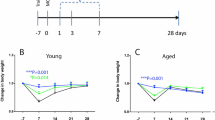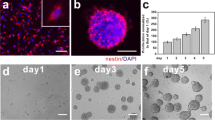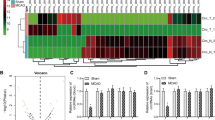Abstract
Ischemic stroke is typified by hypoxia and a cascade of pathophysiological events, including metabolic dysfunction, ionic dysregulation, excitotoxicity, inflammatory infiltration, and oxidative stress. These ultimately result in neuronal apoptosis or necrosis with constrained neuroregenerative capabilities. In this study, neural stem cells (NSCs) under conditions of oxygen–glucose deprivation (OGD) in vitro and following middle cerebral artery occlusion (MCAO) in vivo were explored. Transcriptome sequencing revealed a decline in NSC differentiation and neurogenesis after OGD exposure, which was related to cellular senescence. This observation was corroborated by increased senescence markers in the MCAO mouse model, reduction in NSC numbers, and decline in neurogenesis. Importantly, iMSC-sEVs (induced mesenchymal stem cells-small extracellular vesicles) have the therapeutic potential to alleviate NSC senescence and rejuvenate their regenerative capacities both in vitro and in vivo. Moreover, iMSC-sEVs contribute to the recovery of cognitive function and synapse loss caused by MCAO.






Similar content being viewed by others
Availability of Data and Materials
The datasets used and/or analyzed during the current study are available from the corresponding author upon reasonable request.
References
Anacker C, Luna VM, Stevens GS, Millette A, Shores R, Jimenez JC et al (2018) Hippocampal neurogenesis confers stress resilience by inhibiting the ventral dentate gyrus. Nature 559:98–102
Andrzejewska A, Dabrowska S, Lukomska B, Janowski M (2021) Mesenchymal stem cells for neurological disorders. Adv Sci (weinh) 8:2002944
Ayata C, Dunn AK, Gursoy OY, Huang Z, Boas DA, Moskowitz MA (2004) Laser speckle flowmetry for the study of cerebrovascular physiology in normal and ischemic mouse cortex. J Cereb Blood Flow Metab 24:744–755
Calcinotto A, Kohli J, Zagato E, Pellegrini L, Demaria M, Alimonti A (2019) Cellular senescence: aging, cancer, and injury. Physiol Rev 99:1047–1078
Childs BG, Durik M, Baker DJ, van Deursen JM (2015) Cellular senescence in aging and age-related disease: from mechanisms to therapy. Nat Med 21:1424–1435
Cloonan N, Wani S, Xu Q, Gu J, Lea K, Heater S et al (2011) MicroRNAs and their isomiRs function cooperatively to target common biological pathways. Genome Biol 12:R126
Djavadian RL (2004) Serotonin and neurogenesis in the hippocampal dentate gyrus of adult mammals. Acta Neurobiol Exp (wars) 64:189–200
Drew WG, Miller LL, Baugh EL (1973) Effects of delta9-THC, LSD-25 and scopolamine on continuous, spontaneous alternation in the Y-maze. Psychopharmacologia 32:171–182
Fischer UM, Harting MT, Jimenez F, Monzon-Posadas WO, Xue H, Savitz SI et al (2009) Pulmonary passage is a major obstacle for intravenous stem cell delivery: the pulmonary first-pass effect. Stem Cells Dev 18:683–692
Giovannelli L, Bari E, Jommi C, Tartara F, Armocida D, Garbossa D et al (2023) Mesenchymal stem cell secretome and extracellular vesicles for neurodegenerative diseases: risk-benefit profile and next steps for the market access. Bioact Mater 29:16–35
Gould E, Tanapat P, Rydel T, Hastings N (2000) Regulation of hippocampal neurogenesis in adulthood. Biol Psychiatry 48:715–720
Hong L, Lai M, Chen M, Xie C, Liao R, Kang YJ et al (2010) The miR-17-92 cluster of microRNAs confers tumorigenicity by inhibiting oncogene-induced senescence. Cancer Res 70:8547–8557
Jin K, Wang X, Xie L, Mao XO, Zhu W, Wang Y et al (2006) Evidence for stroke-induced neurogenesis in the human brain. Proc Natl Acad Sci U S A 103:13198–13202
Kim HY, Kim TJ, Kang L, Kim YJ, Kang MK, Kim J et al (2020) Mesenchymal stem cell-derived magnetic extracellular nanovesicles for targeting and treatment of ischemic stroke. Biomaterials 243:119942
Kokaia Z, Lindvall O (2003) Neurogenesis after ischaemic brain insults. Curr Opin Neurobiol 13:127–132
Krupinski J, Kaluza J, Kumar P, Kumar S, Wang JM (1994) Role of angiogenesis in patients with cerebral ischemic stroke. Stroke 25:1794–1798
Lang HL, Zhao YZ, Xiao RJ, Sun J, Chen Y, Hu GW et al (2023) Small extracellular vesicles secreted by induced pluripotent stem cell-derived mesenchymal stem cells improve postoperative cognitive dysfunction in mice with diabetes. Neural Regen Res 18:609–617
Li W, Shi L, Hu B, Hong Y, Zhang H, Li X et al (2021) Mesenchymal stem cell-based therapy for stroke: current understanding and challenges. Front Cell Neurosci 15:628940
Marques BL, Carvalho GA, Freitas EMM, Chiareli RA, Barbosa TG, Di Araújo AGP et al (2019) The role of neurogenesis in neurorepair after ischemic stroke. Semin Cell Dev Biol 95:98–110
Molofsky AV, Slutsky SG, Joseph NM, He S, Pardal R, Krishnamurthy J et al (2006) Increasing p16INK4a expression decreases forebrain progenitors and neurogenesis during ageing. Nature 443:448–452
Mousavinejad M, Andrews PW, Shoraki EK (2016) Current biosafety considerations in stem cell therapy. Cell J 18:281–287
Péron S, Berninger B (2015) Imported stem cells strike against stroke. Cell Stem Cell 17:501–502
Phipps MS, Cronin CA (2020) Management of Acute Ischemic Stroke Bmj 368:l6983
Rahmani A, Saleki K, Javanmehr N, Khodaparast J, Saadat P, Nouri HR (2020) Mesenchymal stem cell-derived extracellular vesicle-based therapies protect against coupled degeneration of the central nervous and vascular systems in stroke. Ageing Res Rev 62:101106
Rost NS, Brodtmann A, Pase MP, van Veluw SJ, Biffi A, Duering M et al (2022) Post-stroke cognitive impairment and dementia. Circ Res 130:1252–1271
Sahay A, Scobie KN, Hill AS, O’Carroll CM, Kheirbek MA, Burghardt NS et al (2011) Increasing adult hippocampal neurogenesis is sufficient to improve pattern separation. Nature 472:466–470
Santarelli L, Saxe M, Gross C, Surget A, Battaglia F, Dulawa S et al (2003) Requirement of hippocampal neurogenesis for the behavioral effects of antidepressants. Science 301:805–809
Sarter M, Bodewitz G, Stephens DN (1988) Attenuation of scopolamine-induced impairment of spontaneous alteration behaviour by antagonist but not inverse agonist and agonist beta-carbolines. Psychopharmacology 94:491–495
Schmidt A, Minnerup J (2016) Promoting recovery from ischemic stroke. Expert Rev Neurother 16:173–186
Théry C, Witwer KW, Aikawa E, Alcaraz MJ, Anderson JD, Andriantsitohaina R et al (2018) Minimal information for studies of extracellular vesicles 2018 (MISEV2018): a position statement of the International Society for Extracellular Vesicles and update of the MISEV2014 guidelines. J Extracell Vesicles 7:1535750
Ullah I, Subbarao RB, Rho GJ (2015) Human mesenchymal stem cells - current trends and future prospective. Biosci Rep 35:e00191
van Praag H, Schinder AF, Christie BR, Toni N, Palmer TD, Gage FH (2002) Functional neurogenesis in the adult hippocampus. Nature 415:1030–1034
Villeda SA, Luo J, Mosher KI, Zou B, Britschgi M, Bieri G et al (2011) The ageing systemic milieu negatively regulates neurogenesis and cognitive function. Nature 477:90–94
Wu S, Wu B, Liu M, Chen Z, Wang W, Anderson CS et al (2019) Stroke in China: advances and challenges in epidemiology, prevention, and management. Lancet Neurol 18:394–405
Xekardaki A, Santos M, Hof P, Kövari E, Bouras C, Giannakopoulos P (2012) Neuropathological substrates and structural changes in late-life depression: the impact of vascular burden. Acta Neuropathol 124:453–464
Xin H, Li Y, Buller B, Katakowski M, Zhang Y, Wang X et al (2012) Exosome-mediated transfer of miR-133b from multipotent mesenchymal stromal cells to neural cells contributes to neurite outgrowth. Stem Cells 30:1556–1564
Xin H, Katakowski M, Wang F, Qian JY, Liu XS, Ali MM et al (2017a) MicroRNA cluster miR-17-92 cluster in exosomes enhance neuroplasticity and functional recovery after stroke in rats. Stroke 48:747–753
Xin H, Wang F, Li Y, Lu QE, Cheung WL, Zhang Y et al (2017b) Secondary release of exosomes from astrocytes contributes to the increase in neural plasticity and improvement of functional recovery after stroke in rats treated with exosomes harvested from microRNA 133b-overexpressing multipotent mesenchymal stromal cells. Cell Transplant 26:243–257
Zhang ZG, Chopp M (2016) Exosomes in stroke pathogenesis and therapy. J Clin Invest 126:1190–1197
Zhang M, Lin YH, Sun YJ, Zhu S, Zheng J, Liu K et al (2016) Pharmacological reprogramming of fibroblasts into neural stem cells by signaling-directed transcriptional activation. Cell Stem Cell 18:653–667
Zhang H, Wu J, Wu J, Fan Q, Zhou J, Wu J et al (2019a) Exosome-mediated targeted delivery of miR-210 for angiogenic therapy after cerebral ischemia in mice. J Nanobiotechnology 17:29
Zhang ZG, Buller B, Chopp M (2019b) Exosomes - beyond stem cells for restorative therapy in stroke and neurological injury. Nat Rev Neurol 15:193–203
Zhou X, Deng X, Liu M, He M, Long W, Xu Z et al (2023) Intranasal delivery of BDNF-loaded small extracellular vesicles for cerebral ischemia therapy. J Control Release 357:1–19
Acknowledgements
This work was supported by the National Natural Science Foundation of China (82272225, 81860249).
Funding
This study was funded by the National Natural Science Foundation of China (82272225, 81860249) and the Wujieping Medical Foundation (320.6750.2021–03-1).
Author information
Authors and Affiliations
Contributions
SW, H-RZ, and J-YL designed the research. J-YL drafted the manuscript. J-YL, LP, L-WH, T-YY, M-MY, PW, Y-HD, JL, and J-BC performed all experiments. J-YL, H-RZ, and SW participated in discussions, data analysis, and manuscript editing. All authors have read and approved the final version of the manuscript.
Corresponding authors
Ethics declarations
Ethics Approval
All animal experiments were carried out in strict accordance with the requirements of the Animal Care and Use Committee of USTC. Male C57/BL6 mice were provided by the Experimental Animal Center of First Affiliated Hospital of USTC, China.
Competing interests
The authors declare no competing interests.
Additional information
Publisher's Note
Springer Nature remains neutral with regard to jurisdictional claims in published maps and institutional affiliations.
Rights and permissions
Springer Nature or its licensor (e.g. a society or other partner) holds exclusive rights to this article under a publishing agreement with the author(s) or other rightsholder(s); author self-archiving of the accepted manuscript version of this article is solely governed by the terms of such publishing agreement and applicable law.
About this article
Cite this article
Liu, J., Peng, L., He, L. et al. Induced Mesenchymal Stem Cells-Small Extracellular Vesicles Alleviate Post-stroke Cognitive Impairment by Rejuvenating Senescence of Neural Stem Cells. J Mol Neurosci 74, 29 (2024). https://doi.org/10.1007/s12031-024-02191-w
Received:
Accepted:
Published:
DOI: https://doi.org/10.1007/s12031-024-02191-w




